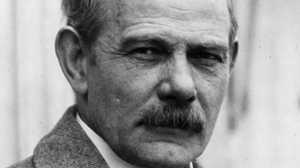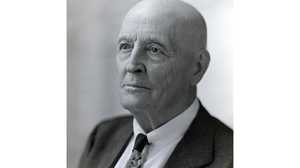Lincoln Borglum

James Lincoln de la Mothe Borglum, called Lincoln, was the first child of Gutzon Borglum and his second wife Mary, born on April 9, 1912. He was named after his father's favorite president, Abraham Lincoln, who, probably not coincidentally, was the subject of the work that made Gutzon's national reputation as a sculptor. (The bust of the president was displayed in a storefront window on Fifth Avenue in New York, at the White House for the centennial of the president's birth, and eventually bought and installed in the Capitol rotunda in Washington.)
While still a boy, Lincoln accompanied his father to South Dakota and was present when the site of Rushmore was selected. He was there for every dedication of the monument and was on site for much of the work -- he eventually spent more time on the mountain than his father.
In 1933, at the age of 21, Lincoln became a full-time pointer, although unpaid. His original plan was to study engineering at the University of Virginia, but Gutzon had his own ambitious plans for his son. Thus the position as pointer, a high-status job that required experience and good judgment. "The Old Man was always trying to push Lincoln along -- to make him important," an old Rushmore hand recalled. "Lincoln never let it go to his head. He didn't know much about what he was doing at first, but he was such a nice kid that all the other pointers helped him out until he learned to do it by himself, so it all worked out OK. Lincoln was a good guy to work with."
Lincoln proved especially valuable to the project as he had inherited many of his father's artistic talents and none of his artist's temperament. Although from back East, and of a much wealthier class than the South Dakota crew, he was considered one of the guys. On game days, he would park his car near the hoist house so that the hoist operator could listen to baseball scores and telephone the developments to the men on the mountain.
In 1934, the Mount Rushmore Commission put Lincoln on the payroll at a dollar an hour -- not an insignificant sum during the Depression. In 1937, he functioned as the project sculptor in his father's absence. He proved to be an artist in his own right. (Lincoln's artistic talents included photography -- his photos illustrated articles on Rushmore that appeared in the Saturday Evening Post.) The next year, after his father had driven away the latest in a series of competent engineers and managers, Lincoln was promoted to superintendent, with an annual salary of $4,800.
In 1939, a bust sculpted by Korczak Ziolkowski won a gold prize at the World's Fair in New York, and Gutzon Borglum invited him to serve as an assistant at Rushmore. After only 19 days in the Black Hills, though, Ziolkowski and Lincoln Borglum got into a heated argument and a physical altercation. Lincoln was a husky young man, but Ziolkowski was a bear, and Lincoln had to go into town for medical attention after the fight. Undoubtedly Lincoln would not have asked for Ziolkowski's dismissal, but Gutzon certainly couldn't allow the workmen to think that assaulting the superintendent was an act that went unpunished and so Ziolkowski was let go.
After his father died, Lincoln Borglum was interviewed on the radio and asked about his plans. "The sculpture work on the faces was completed before Father's death, and the features of the four presidents will not be touched. We've got to finish the hair on Jefferson, Roosevelt, and Lincoln and do some work on Lincoln's collar and on his head. That's the immediate program." Lincoln was ideally suited to complete Mount Rushmore to the state that it stands today. After work ended on October 31, 1941, Lincoln said: "I do not thi
Lincoln continued to work as a sculptor after leaving Rushmore, creating a number of religious works for churches in Texas, including Our Lady of Loreto in Goliad, Texas. He wrote three books: My Father's Mountain (1965), Borglum's Unfinished Dream (with June Culp Zeitner, 1976), and Mount Rushmore: The Story Behind the Scenery (1977).
Lincoln served as superintendent of the Mount Rushmore National Memorial from October 1, 1941 through May 15, 1944. Like many of the men who worked on Rushmore, Lincoln's lungs were permanently scarred from breathing granite dust for so many years. On January 27, 1986, Lincoln Borglum died in Corpus Christi, Texas. An enlargement of his bust of Gutzon Borglum (produced by his son, Jim, and Korczak Ziolkowski's daughter, Monique) now stands outdoors not far from the Lincoln Borglum Visitors Center at Mount Rushmore.
Lincoln Borglum was as dedicated to Mount Rushmore as anyone could be. His daughter remembered him say, "I've climbed over every inch of that damn mountain and I still get a lump in my throat every time I see it."







